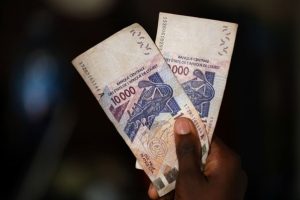Ksenzhuk (2018) asserts in the publication titled “Determinant of the development of the precious metals market and peculiarities of investments in precious metals” that gold reserves play a key part in the global economy. Numerous countries uphold substantial quantities of gold within their foreign reserves. Research findings have demonstrated that certain nations, including the United States, Italy, France, Switzerland, Japan, the Netherlands, and India, have consistently maintained consistent levels of gold reserves throughout their respective histories. The presence of gold reserves has implications for maintaining the stability and trust of the global economy. Gold reserves play an integral part in ensuring financial stability and facilitating strategic decision-making in various countries. In the context of economic difficulties, currency volatility, and geopolitical concerns, these reserves serve as a protective measure. The United States occupies an important position in the global economic scene due to its substantial gold reserves. The gold reserves of the country serve as a strong basis for its currency and enhance its status as a significant participant in global finance. In a similar vein, nations such as Italy, France, and Switzerland have traditionally upheld substantial quantities of gold reserves, so demonstrating their dedication to ensuring financial stability and fortitude.
Gold reserves play an essential function in mitigating currency risk and market volatility for countries such as Japan and the Netherlands. These nations place a high emphasis on the acquisition of gold in order to broaden their foreign reserves and reduce the impact of any economic disruptions. Furthermore, gold reserves provide a heightened level of assurance and assurance to investors, central institutions, and the broader populace, particularly in periods characterized by economic upheaval. India, renowned for its cultural fondness for gold, possesses significant reserves as a representation of affluence and success. The gold deposits in India possess significance not alone as a financial asset, but also as a cultural phenomenon deeply ingrained in social behaviors and customs. The nation’s gold reserves are indicative of its historical association with the valuable metal and its significance in religious rituals, nuptials, and celebrations.

Although financial markets have evolved and digital currencies have gained popularity, gold continues to be a reliable and enduring store of value, serving as a trusted asset for central banks and governments around. The inherent characteristics of this entity, such as its limited availability, long-lasting nature, and widespread recognition, guarantee its significance in the contemporary economy. Amidst ongoing economic difficulties and geopolitical concerns, gold reserves will continue to play a vital role in the financial plans of nations, offering stability, security, and assurance in a constantly evolving global landscape. The authors Trabelsi et al. (2021) argue in their publication titled “Effects of price of gold on Bombay Stock Exchange Sectoral Indices: New Evidence for Portfolio Risk Management” that maintaining stability is necessary for nations in preserving their exchange rates and overall economic stability.
According to Ivanchenko et al. (2022), in their study titled “Role of gold in Russia’s modern monetary system,” central banks have persistently accumulated gold reserves in the aftermath of the financial crisis. This is due to the perception that gold acts as a reliable asset in times of economic uncertainty.
According to Starr & Tran’s study “Determinants of the physical demand for gold: evidence from panel data” published on World Economy (2008), gold continues to be a valuable means of preserving wealth and serves as an indicator of changing perceptions of risk. According to a study conducted by Aizenman and Inoue (2013) and published in the Journal of the Japanese and International Economies, it has been observed that central banks exhibit coordination in their gold sales and prefer to remove gold positions when reporting the valuation of international reserves. In addition, Rathi et al. (2021) argue in their publication “Central bank gold reserves and sovereign credit risk” that gold has a beneficial impact on reducing a nation’s external vulnerabilities in an unpredictable global economic environment.
The geological dimension of gold reserves is of utmost importance, as evidenced by the presence of significant gold deposits in locations such as the Jiaodong Peninsula in China.
This was reflected by authors such as Song et al., in “Types, characteristics and metallogenesis of gold deposits in the Jiaodong peninsula, Eastern North China craton” published on Ore Geology Reviews (2015); Chai et al., in “Geology, fluid inclusion, and h–o–s–pb isotope constraints on the mineralization of the xiejiagou gold deposit in the jiaodong peninsula” published on Geofluids (2019); and Zhang et al., in “Hydrothermal alteration and gold mineralization in the Jiaojia gold deposit, Jiaodong peninsula, China” published on Acta Geologica Sinica English Edition (2014). Chai et al. (2017) emphasized the importance of comprehending the geology, fluid evolution, and mineralization processes in the Xiadian gold deposit, Jiaodong peninsula. This understanding is crucial for assessing gold reserves and potential extraction prospects.
The impact of monetary policy on the dynamics of gold prices has been recognized, with the volatility of gold prices being influenced by political attitudes and events, as highlighted by Zhu et al. in their publication titled “The impact of monetary policy on gold price dynamics” in the journal Research in International Business and Finance (2018).
In summary, gold reserves continue to serve as an essential asset for numerous countries, providing stability, value, and a secure refuge amongst periods of economic instability. The global dynamics of gold reserves are influenced by the complex interaction of economics, geology, and monetary policy, highlighting the multidimensional characteristics of gold as both a valuable commodity and a strategic reserve asset.
A gold reserve is the gold held by a national central bank, intended mainly as a guarantee to redeem promises to pay depositors, note holders (e.g. paper money), or trading peers, during the eras of the gold standard, and also as a store of value, or to support the value of the national currency. The World Gold Council estimates that all the gold ever mined, and that is accounted for, totalled 190,040 metric tons in 2019 but other independent estimates vary by as much as 20%. At a price of US$1,250 per troy ounce ($40 per gram) reached on 16 August 2017, one metric ton of gold has a value of approximately $40.2 million. The total value of all gold ever mined, and that is accounted for, would exceed $7.5 trillion at that valuation and using WGC 2017 estimates. Why do countries keep gold reserves? Because gold reserves are critical for the economic stability of a country, acting as a reliable store of value, particularly during financial uncertainties. The gold standard was a global practice in the late 1800s and a significant part of the 1900s. In this era, countries backed the value of their paper money with gold by establishing a fixed exchange rate between their currency and a specific amount of gold. Essentially, each unit of currency issued had a corresponding value in gold, and individuals could exchange their paper money for actual gold at this set rate.
Why do countries have a gold reserve?
Countries maintain gold reserves for several reasons.
Firstly, gold is considered a stable and reliable store of value. By holding gold, countries can instil confidence in their economic stability, especially during financial uncertainty. Additionally, gold has historically played a role in supporting the value of a country’s currency. While the gold standard is no longer widely used, some countries still view gold reserves as a means to maintain currency stability. Diversification is another key reason. Gold is a tangible asset; by holding it in their reserves, countries can diversify their overall portfolio. This diversification helps mitigate the risks associated with fluctuations in the value of other assets. The appeal of gold is heightened by its inverse correlation with the US dollar. When the value of the dollar declines, gold tends to increase in value. This dynamic allows central banks to safeguard their reserves during periods of market volatility. Gold reserves also have a role in international trade and finance. Some countries use gold to settle trade imbalances or as collateral for loans. The presence of gold reserves can enhance a country’s creditworthiness and influence its standing in the global economic system. Moreover, gold serves as a hedge during crises. Its value often rises during economic downturns or geopolitical uncertainties, safeguarding against inflation and currency devaluation.
Wartime relevance
During most of history, a nation’s gold reserves were considered its key financial asset and a major prize of war.
A typical view was expressed in a secret memorandum by the British Chief of the Imperial General Staff from October 1939, at the beginning of World War II. The British Military and the British Secret Service laid out “measures to be taken in the event of an invasion of Holland and Belgium by Germany” and presented them to the War Cabinet: It will be for the Treasury in collaboration with the Bank of England, and the Foreign Office, to examine the possible means of getting the bullion and negotiable securities into the same place of safety. The transport of many hundreds of tons of bullion presents a difficult problem and the loading would take a long time. The ideal would of course be to have the gold transferred to this country or to the United States of America. […] The gold reserves of Belgium and Holland amount to about £70 million and £110 million respectively. [Foot]Note: H. M. Treasury has particularly requested that this information, which is highly confidential should in no circumstances be divulged. The total weight of this bullion amounts to about 1800 tons and its evacuation would be a matter of the utmost importance would present a considerable problem if it had to be undertaken in a hurry when transport facilities were disorganized. At present this gold is believed to be stored at Brussels and The Hague respectively, neither of which is very well placed for its rapid evacuation in an emergency.
The Belgian government transferred remainder to southern France. Following the outbreak of war, the gold held in France was sent to Dakar, the capital of Senegal, then part of the French colonial empire. This was against the Belgian Government’s wishes, with the Belgians having directed the French to transfer it to the United States. After the Germans occupied Belgium and France in 1940, they demanded the Belgian gold reserve held in Senegal. In 1941, Vichy French officials arranged the transport of 4,944 boxes with 198 tonnes of gold to officials of the German Reichsbank and the German Government used it to purchase commodities and munitions from neutral countries. The Banque de France fully compensated the Belgian National Bank for the loss of its gold after the war.
IMF holdings
Since early 2011, the gold holdings of the IMF have been constant at 2,814.1 tonnes (90.5 million troy ounces).
Officially reported holdings. The IMF regularly maintains statistics of national assets as reported by various countries This data is used by the World Gold Council to periodically rank and report the gold holdings of countries and official organizations. On 17 July 2015, China announced that it increased its gold reserves by about 57 percent from 1,054 to 1,658 tonnes, while disclosing its official gold reserves for the first time in six years. In July 2015, the State Bank of Vietnam stated that gold reserves totalled 10 tonnes. However, it was not ranked below due to the current absence of any published data.
In 2019, the State Oil Fund of the Republic of Azerbaijan (SOFAZ) extended the gold allocation limit from 5% to 10%, in accordance with the amendments made to the Investment Policy of the Fund for diversification purposes.However, the Central Bank of Azerbaijan does not hold any gold.
The gold listed for each of the countries in the table may not be physically stored in the country listed, as central banks generally have not allowed independent audits of their reserves. Gold leasing by central banks could place into doubt the reported gold holdings in the table below.
| Top 50 according to World Gold Council’s latest rankings (as of 2 August 2024) | |||
| Rank | Country/Organization | Gold holdings (in metric tons) |
Gold’s share of forex reserves |
| 1 | United States | 8,133.5 | 72.4% |
| 2 | Germany | 3,351.5 | 71.5% |
| — | International Monetary Fund | 2,814.0 | —[a] |
| 3 | Italy | 2,451.8 | 68.3% |
| 4 | France | 2,436.8 | 69.9% |
| 5 | Russia | 2,332.74 | 29.5% |
| 6 | China | 2,264.3 | 4.9% |
| 7 | Switzerland | 1,040.0 | 8.0% |
| 8 | India | 853.63 | 9.32% |
| 9 | Japan | 845.9 | 5.1% |
| 10 | Netherlands | 612.4 | 61.6% |
| 11 | Turkey | 584.9 [b] | 100% |
| — | European Central Bank | 506.5 | 33.9% |
| 12 | Poland | 448[12] | 17.7% |
| 13 | Taiwan | 422.4 | 4.7% |
| 14 | Portugal | 382.6 | 74.0% |
| 15 | Uzbekistan | 365.1 | 75.2% |
| 16 | Iraq | 355.4 | 12.5% |
| 17 | Saudi Arabia | 323.1 | 4.7% |
| 18 | United Kingdom | 310.2 | 13.4% |
| 19 | Kazakhstan | 298.8 | 56.0% |
| 20 | Lebanon | 286.8 | 54.5% |
| 21 | Spain | 281.6 | 20.1% |
| 22 | Austria | 279.9 | 63.2% |
| 23 | Thailand | 234.5 | 7.8% |
| 24 | Singapore | 228.8 | 4.4% |
| 25 | Belgium | 227.4 | 39.9% |
| 26 | Algeria | 173.6 | 15.1% |
| 27 | Venezuela | 161.2 | 83.0% |
| 28 | Philippines | 159.1 | 10.2% |
| 29 | Libya | 146.7 | 11.2% |
| 30 | Brazil | 129.6 | 2.7% |
| 31 | Egypt | 126.5 | 21.4% |
| 32 | Sweden | 125.7 | 15.2% |
| 33 | South Africa | 125.4 | 15.1% |
| 34 | Mexico | 120.1 | 3.9% |
| 35 | Greece | 114.4 | 60.3% |
| 36 | Hungary | 110.0 | 14.3% |
| 37 | Qatar | 106.4 | 15.1% |
| 38 | South Korea | 104.4 | 1.7% |
| 39 | Romania | 103.6 | 10.1% |
| — | Bank for International Settlements | 102.0[c] | —[a] |
| 40 | Australia | 79.8 | 10.1% |
| 41 | Kuwait | 79.0 | 10.0% |
| 42 | Indonesia | 78.6 | 3.6% |
| 43 | United Arab Emirates | 74.5 | 2.6% |
| 44 | Jordan | 70.0 | 26.6% |
| 45 | Denmark | 66.5 | 4.1% |
| 46 | Pakistan | 64.7 | 31.3% |
| 47 | Argentina | 61.7 | 15.9% |
| 48 | Belarus | 54.0 | 48.4% |
| 49 | Finland | 49.0 | 21.0% |
| 50 | Serbia | 48[13] | 13% [14] |
| — | World | 35,938.6[d] | 15.2% |
| — | Euro Area (including the ECB) | 10,771.5 | 56.4% |
- Notes
- BIS and IMF balance sheets do not allow this percentage to be calculated.
- · The figure provided is official sector gold reserves, i.e. the sum of central bank owned gold and Treasury gold holdings. This is equivalent to gross gold reserves less all gold held at the central bank in relation to commercial sector gold policies, such as the Reserve Option Mechanism (ROM), collateral, deposits, and swaps.
- · Excluding any gold held in connection with swap operations, under which the bank exchanges currencies for physical gold. The bank has an obligation to return this gold at the end of the contract.
- World total as calculated by the IMF. This will not equal the total for the countries in the table as ‘World total’ will include data for countries beyond the top 100 and for countries that do not publish their reserves. World total also captures BIS holdings inclusive of swap operations.



















